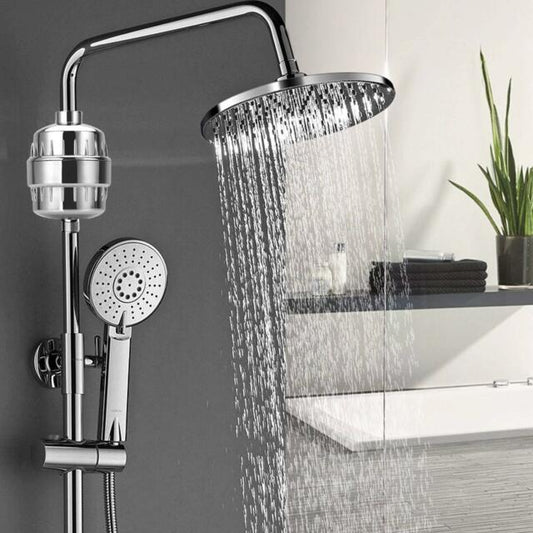Water treatment facilities across the world add fluoride and chlorine to water to reduce the amount of bacteria, viruses, and other pathogens infecting the local water supply. When it comes to getting rid of those contaminants, there’s no doubt that chlorine and fluoride are effective – but, when it comes to drinking disinfectant chemicals, you’re probably more than a little hesitant.
It doesn’t matter if it’s a gallon or a thousandth of a milliliter, if you don’t want to be drinking fluoride and chlorine, you shouldn’t have to. In that case, you should look into buying the FilterSmart, the best whole house water
filter to remove fluoride and chlorine.
How does the FilterSmart Remove Chlorine from Drinking Water?

Whole house water filters, like the FS1000, our Premium Whole House Water Filter, work by utilizing a three step-process: pre-filtering, chlorine removal through carbon filtering, and waste removal. They’re installed at the water’s first point of entry in your home, filtering all of the water in your house – not just the drinking water.
Pre-Filtering: Getting Rid of the Big Stuff
Before you can actually remove chlorine and other similar contaminants from your water, you need to get rid of the larger particles. This is where pre-filtering comes in. It gets rid of anything up to about five microns wide. A micron is a unit of measure in the metric system that equals one millionth of a meter in length. The human eye is physically incapable of seeing anything the size of about 40 microns, a little smaller than the diameter of human hair.
If your water looks hazy or milky, there’s a chance that there are small particles of dirt, sand, or other sediment floating around in it. While you can’t see the individual particles, they might add up to a significant amount.
Pre-filtering gets rid of those bigger particles that are not only physically bad for you but also potentially harmful to the appliances in your home. Your Keurig coffee maker, for example, was designed to filter coffee grounds, not sand. You might not even be able to see those tiny particles of dust, silt, rust, and debris floating around in your water, but they will damage expensive appliances – like your washing machine, dishwasher, plumbing, and even coffee maker – and force you to replace them on an annoyingly regular basis. Pre-filtering, then, is one step in a process that could save you tons of money down the line.
Chlorine and Fluoride Removal Through Carbon Filtering
Next up is the step that we’ve all been waiting for: chlorine and fluoride removal. After removing larger sediments, our whole house water filters remove chlorine through a process called carbon filtering. Carbon filtering works by changing the electronic molecular charges in your water. A tightly packed block of carbon can change the chemical structures of lead, pesticides, fluoride and chlorine – and that’s why it’s included in our whole house water filter.
Removing chlorine and fluoride from your water will make it look and taste better. There are some experts out there who claim that a certain amount of fluoride is good for your teeth. Adding fluoride to the water supply, for example, reduces the incidence of tooth decay in certain municipalities. This is undoubtedly true, but that doesn’t mean that you can’t receive a healthy dose of fluoride in other ways. Toothpaste, for example, is almost always made with a mindful amount of fluoride.
Reverse Osmosis Can Remove to Remove 99.9% of Fluoride and Chlorine
Our reverse osmosis systems remove fluoride and chlorine from your main water source. Put simply, reverse osmosis is the underlying system behind how our product removes dangerous water contaminants.
In order to understand reverse osmosis, you first need to understand regular osmosis. Osmosis occurs when a dilute solution passes through a semi-permeable membrane to a more concentrated solution. For example: raisins.
Raisins are dehydrated grapes. If you want to watch osmosis in action, soak a raisin in water. The water (dilute solution) will pass through the skin of the raisin (a semi-permeable membrane) and rehydrate the raisin (a very concentrated solution -- so concentrated, in fact, it’s mostly a solid).
Reverse osmosis, then, is the opposite. It pushes concentrated solution (like water contaminated with fluoride and chlorine) and forces it through a filter (a semi-permeable membrane) so that the chlorine and fluoride stays on one side of the filter and clear, purified water (dilute solution) goes through the other. The major difference is that osmosis is a passive process while reverse osmosis requires quite a bit of pressure.
The FilterSmart, the best whole house water filter to remove fluoride and chlorine, uses reverse osmosis to ensure that you have clear, refined water that has absolutely no dangerous disinfectants.
Pharmaceutical-Grade Waste Removal
This is the final step if you want to use our whole house water filter to remove fluoride and chlorine. The post-filter ensures that the other two steps were successful. It also ensures that the carbon block doesn’t seep its way into your water supply.
After all, you don’t want to replace chlorine and fluoride with something else entirely. If you want to stay as healthy as possible, you need to be aware of the chemicals that are added to your water.
What are the Possible Health Dangers of Fluoride and Chlorine
Finally, let’s dive into why you might want to buy the FilterSmart, the best whole house water filter to remove fluoride and chlorine.
According to the American Cancer Society, fluoride is present in the water supplied to about 3 out of every 4 Americans. Since its inception in the early 1940s, people have been skeptical of its safety for legitimate and, well, less-than-legitimate reasons.
Fluoride and Cancer Risk
In the 1960s, one study found uncertain evidence that excess levels of fluoride might lead to an increased risk of a specific type of cancer called osteosarcoma. Fluoride collects in the parts of the body where bones are growing, and since osteosarcomas also form in those parts of the body (growth plates), it logically follows that there may be a connection between the two. While this may be possible, osteosarcoma is an incredibly rare cancer that only affects about 400 people per year. To put that statistic into perspective, about as many people die from osteosarcoma as those who die from being struck by lightning (per year, across the world).
However, that’s not to say that there are no health risks associated with high levels of fluoride consumption. If there were no dangers, the EPA wouldn’t be regulating the amount of fluoride in the water supply. They’d just pour it in and make sure that everyone was drinking as much as possible.
Young Children and Dental Fluorosis
The EPA has set a standard of less than 2mg/dl to help protect children from dental fluorosis. When too much fluoride collects in growing teeth, it can halt the proper maturation of the teeth, preventing enamel from forming. As a result, your childrens’ teeth may be permanently stained or pitted.
Chlorine Consumption and Health Risks
Now that fluoride is out of the way, what about the consumption of chlorine? Does even a small amount of chlorine consumption have any tangible benefits?
The incredibly small amount of chlorine in your water is probably nothing to worry about. Americans have been drinking some form of chlorinated water for the past 100 years without any serious, wide- spread health concerns. Societally, it makes more sense to eliminate the pathogens that could carry a pandemic across the nation rather than worry about the infinitely small amount of chlorine in the water supply.
However, cancer rates are increasing across the world. Some modern development -- whether it’s fast food, cell phones, or chlorine in water -- has to be behind it. If you’re worried that there’s a connection between trace disinfectant consumption and your risk of cancer, you need to buy the FilterSmart. It’s the best whole house water filter to remove fluoride and chlorine. Why worry about it at all? If you could put a price tag on peace of mind, we guarantee it would cost more than our filters, so why wait?
Conclusion
The whole house water filter works by pre-filtering large sediments of dust, rust, silt, and sand from the water, and then it uses a tightly-packed carbon block to change the molecular structure of dangerous contaminants before using a pharma-grade filter to ensure that your water is healthy to drink. If you have any fears about chlorine and fluoride consumption, take a look at our selection today.
Questions? Concerns? Feel free to get in touch:
Call us: 866.455.9989
Email us: sales@filtersmart.com






